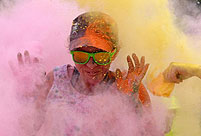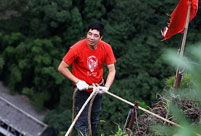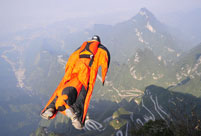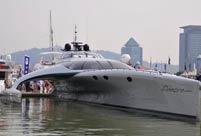A complete, encircling city wall was built by Emperor Hongwu (1368-98) who founded the Ming Dynasty (1368-1644). The wall is the foundation of today's city wall.
Not only was Dali the political and economic center of two important kingdoms, Nanzhao and Dali, but it was also the inspiration of many legends and romantic tales, especially in martial arts fiction.
One of the most famous martial arts novels involving Dali is "Demi-Gods and Semi-Devils" (first serialized in 1963) by renowned Hong Kong author Jin Yong (Louis Cha Leung-yung). One of the three heroes is a prince from the Dali Kingdom who refuses to learn martial arts because of Buddhist influence. He runs away from home when his father and the king force him to learn to fight. He gains powers and finds adventure, intrigue beautiful women in the mountainous area. The book was made into TV series and movies.
Dali is always described as a natural paradise surrounded by beautiful mountains and lakes. Colorful flowers bloom everywhere and people of different ethnic groups and cultures live together in harmony.
Judging from the environment of Dali today, the novels of paradise-like beauty were definitely right.
The climate is mild, with temperatures averaging 25 degrees Celsius in summer and 15 degrees Celsius in winter.
From the top of the city wall, you can see the 4,000-meter-high Cangshan Mountains rising to the west. They are covered by green and white clouds and mist floats around the middle like a white ribbon.
Looking to the east and you can see large Erhai Lake, the "mother lake" of Dali, with mountains on the other side.
The wall
Today's Dali city wall was renovated in the 1980s, based on the Ming Dynasty city wall. It had four main gates, one in each of four directions; several streets ran south to north and eight smaller streets ran from east to west inside the wall.
The South Gate is the largest and the entry point where you climb steps to the top of the wall. From there, you have a bird's-eye view of the whole city to the north, with the central street (Fuxing Road) running to the North Gate.
All that's left of the encircling wall is an L-shape consisting of the western and southern sections where visitors can walk.
Since the wall is 8.3 meters high, far higher than most buildings, walking along it is like walking on top of the ancient city.
Many old structures are built in traditional Bai ethnic style with white walls, black tiles and upturned eaves. Courtyards are planted with trees and flowers.
A walk along the wall offers beautiful views and takes less than an hour. When I returned to South Gate, the quiet "sleeping swan" had been transformed into a swarming tourist spot and was more like a magpie. All the tourist shops were open.
The main north-south street, Fuxing Road, is filled with boutiques selling souvenirs, garments, textiles, crafts, silver and stone carving. Famous Yunnan coffee and Yunnan Pu'erh tea are also sold. The famous local marbled stone is called Dali Stone in China and is only found in the area.
Not far from the South Gate is the landmark of Dali ancient city, Wuhua Tower. This tower is a downsized modern reproduction of the vast national guesthouse of the Nanzhou Kingdom where foreign envoys lived during their visits.
The tower was destroyed early in the Yuan Dynasty when Kublai Khan's army conquered Yunnan Province.
The rebuilt version is much smaller, but still at the center of the ancient city. The tower's sign "Dali" in Chinese characters was written by famous litterateur Guo Moruo (1892-1978) and has become the "signature" of the city.
As tourists know, Dali combines features of the exotic East, exotic ethnic groups and the West.


 2013 Colour Me Rad 5K run held in Canada
2013 Colour Me Rad 5K run held in Canada China's destroyer Qingdao sails out of Sydney Harbor
China's destroyer Qingdao sails out of Sydney Harbor Chinese tycoon aims to restore London's Crystal Palace
Chinese tycoon aims to restore London's Crystal Palace Worst flooding hits Yuyao, 70% of downtown area underwater
Worst flooding hits Yuyao, 70% of downtown area underwater Game for the brave: 'Spiders' in Yandang Mountains
Game for the brave: 'Spiders' in Yandang Mountains Hungarian wingsuit flyer confirmed dead in Zhangjiajie
Hungarian wingsuit flyer confirmed dead in Zhangjiajie Chinese screen goddesses from Beijing Film Academy
Chinese screen goddesses from Beijing Film Academy  Weekly Sports Photos
Weekly Sports Photos World's most amazing yacht on display in Guangzhou
World's most amazing yacht on display in Guangzhou Photo collection of Chinese Navy
Photo collection of Chinese Navy Photo story: Young tenants in Beijing
Photo story: Young tenants in Beijing Twins Culture Festival kicks off in Beijing
Twins Culture Festival kicks off in Beijing UNESCO world heritage site: Montale Tower
UNESCO world heritage site: Montale Tower Israeli drone crashes into Mediterranean, fragments recovered
Israeli drone crashes into Mediterranean, fragments recovered Fiber-optic wedding dress show shinning in Suzhou
Fiber-optic wedding dress show shinning in Suzhou Day|Week|Month